| dc.contributor.author | Ayhan, Dilay Hazal | en_US |
| dc.contributor.author | Tamer, Yusuf Talha | en_US |
| dc.contributor.author | Akbar, Mohammed | en_US |
| dc.contributor.author | Bailey, Stacey M. | en_US |
| dc.contributor.author | Wong, Michael | en_US |
| dc.contributor.author | Daly, Seth M. | en_US |
| dc.contributor.author | Greenberg, David E. | en_US |
| dc.contributor.author | Toprak, Erdal | en_US |
| dc.date.accessioned | 2016-11-18T20:04:57Z | |
| dc.date.issued | 2016 | en_US |
| dc.identifier.citation | Ayhan, Dilay Hazal, Yusuf Talha Tamer, Mohammed Akbar, Stacey M. Bailey, Michael Wong, Seth M. Daly, David E. Greenberg, and Erdal Toprak. 2016. “Sequence-Specific Targeting of Bacterial Resistance Genes Increases Antibiotic Efficacy.” PLoS Biology 14 (9): e1002552. doi:10.1371/journal.pbio.1002552. http://dx.doi.org/10.1371/journal.pbio.1002552. | en |
| dc.identifier.issn | 1544-9173 | en |
| dc.identifier.uri | http://nrs.harvard.edu/urn-3:HUL.InstRepos:29407562 | |
| dc.description.abstract | The lack of effective and well-tolerated therapies against antibiotic-resistant bacteria is a global public health problem leading to prolonged treatment and increased mortality. To improve the efficacy of existing antibiotic compounds, we introduce a new method for strategically inducing antibiotic hypersensitivity in pathogenic bacteria. Following the systematic verification that the AcrAB-TolC efflux system is one of the major determinants of the intrinsic antibiotic resistance levels in Escherichia coli, we have developed a short antisense oligomer designed to inhibit the expression of acrA and increase antibiotic susceptibility in E. coli. By employing this strategy, we can inhibit E. coli growth using 2- to 40-fold lower antibiotic doses, depending on the antibiotic compound utilized. The sensitizing effect of the antisense oligomer is highly specific to the targeted gene’s sequence, which is conserved in several bacterial genera, and the oligomer does not have any detectable toxicity against human cells. Finally, we demonstrate that antisense oligomers improve the efficacy of antibiotic combinations, allowing the combined use of even antagonistic antibiotic pairs that are typically not favored due to their reduced activities. | en |
| dc.language.iso | en_US | en |
| dc.publisher | Public Library of Science | en |
| dc.relation.isversionof | doi:10.1371/journal.pbio.1002552 | en |
| dc.relation.hasversion | http://www.ncbi.nlm.nih.gov/pmc/articles/PMC5025249/pdf/ | en |
| dash.license | LAA | en_US |
| dc.subject | Medicine and Health Sciences | en |
| dc.subject | Pharmacology | en |
| dc.subject | Drugs | en |
| dc.subject | Antimicrobials | en |
| dc.subject | Antibiotics | en |
| dc.subject | Biology and Life Sciences | en |
| dc.subject | Microbiology | en |
| dc.subject | Microbial Control | en |
| dc.subject | Antimicrobial Resistance | en |
| dc.subject | Antibiotic Resistance | en |
| dc.subject | Physical Sciences | en |
| dc.subject | Materials Science | en |
| dc.subject | Materials by Structure | en |
| dc.subject | Oligomers | en |
| dc.subject | Genetics | en |
| dc.subject | Mutation | en |
| dc.subject | Deletion Mutation | en |
| dc.subject | Medical Microbiology | en |
| dc.subject | Microbial Pathogens | en |
| dc.subject | Bacterial Pathogens | en |
| dc.subject | Pathology and Laboratory Medicine | en |
| dc.subject | Pathogens | en |
| dc.subject | Drug Interactions | en |
| dc.subject | Materials by Attribute | en |
| dc.subject | Pigments | en |
| dc.subject | Dyes | en |
| dc.subject | Fluorescent Dyes | en |
| dc.subject | Biology and life sciences | en |
| dc.subject | Biochemistry | en |
| dc.subject | Nucleic acids | en |
| dc.subject | RNA | en |
| dc.subject | Messenger RNA | en |
| dc.title | Sequence-Specific Targeting of Bacterial Resistance Genes Increases Antibiotic Efficacy | en |
| dc.type | Journal Article | en_US |
| dc.description.version | Version of Record | en |
| dc.relation.journal | PLoS Biology | en |
| dash.depositing.author | Wong, Michael | en_US |
| dc.date.available | 2016-11-18T20:04:57Z | |
| dc.identifier.doi | 10.1371/journal.pbio.1002552 | * |
| dash.contributor.affiliated | Wong, Michael | |


